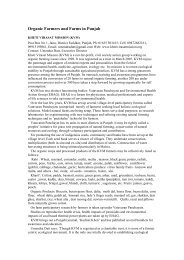Western Ghats Kokum Foundation - Organic Farming Association of ...
Western Ghats Kokum Foundation - Organic Farming Association of ...
Western Ghats Kokum Foundation - Organic Farming Association of ...
Create successful ePaper yourself
Turn your PDF publications into a flip-book with our unique Google optimized e-Paper software.
Emerging role <strong>of</strong> Garcinol, the antioxidant chalcone from Garcinia indica Choisy and<br />
its synthetic analogs<br />
Subhash Padhye, Aamir Ahmad, Nikhil Oswal, and Fazlul H Sarkar<br />
Department <strong>of</strong> Pathology, Barbara Ann Karmanos Cancer Center and Wayne State<br />
University School <strong>of</strong> Medicine, Detroit, MI 48201, USA and D.Y. Patil University <strong>of</strong><br />
Pharmaceutical Sciences and Research, Pune 411018, India<br />
Garcinol, harvested from Garcinia indica, has traditionally been used in tropical<br />
regions and appreciated for centuries; however its biological properties are only beginning<br />
to be elucidated. There is ample data to suggest potent antioxidant properties <strong>of</strong> this<br />
compound which have been used to explain most <strong>of</strong> its observed biological activities.<br />
However, emerging evidence suggests that garcinol could be useful as an anti-cancer agent,<br />
and it is increasingly being realized that garcinol is a pleiotropic agent capable <strong>of</strong><br />
modulating key regulatory cell signaling pathways. Here we have summarized the progress<br />
<strong>of</strong> our current research knowledge on garcinol and its observed biological activities. We<br />
have also provided an explanation <strong>of</strong> observed properties based on its chemical structure<br />
and provided an insight into the structure and properties <strong>of</strong> chalcones, the precursors <strong>of</strong><br />
garcinol. The available data is promising but more detailed investigations into the various<br />
properties <strong>of</strong> this compound, particularly its anti-cancer activity are urgently needed, and it<br />
is our hope that this review will stimulate further research for elucidating and appreciating<br />
the value <strong>of</strong> this nature's wonder agent.<br />
It is difficult to imagine that the pink sweet smelling drink that is served to the world<br />
travelers spending summer holidays on the beautiful beaches <strong>of</strong> Goa in India, upon their<br />
arrival at the hotel, could one day end up on the laboratory tables <strong>of</strong> Cancer Institutes<br />
around the world. The welcome drink happens to be made from the syrup formulated from<br />
the fruits locally known as '<strong>Kokum</strong>' which is steeped in sugar syrup to make a drink which is<br />
used to avoid skin damages and allergies from the sun and tropical climate. The plant grows<br />
extensively on the western coast <strong>of</strong> India and is known by various names across India<br />
including Bindin, Biran, Bhirand, Bhinda, Katambi, Panarpuli, Ratamba or Amsool. In<br />
English language, it is also known by various names such as Mangosteen, wild Mangosteen,<br />
or Red Mango. According to botanical classification the tree is classified as Garcinia indica<br />
(Family: Clusiaceae; Genus: Garcinia)which has many culinary, pharmaceutical and<br />
industrial uses. The genus Garcinia includes some 200 species found in the tropics,<br />
especially Asia and Africa. Out <strong>of</strong> 35 species found in India, 17 are endemic. Of these, seven<br />
are endemic to the region <strong>of</strong> <strong>Western</strong> <strong>Ghats</strong> including the state <strong>of</strong> Goa, six in the Andaman<br />
and Nicobar Islands and four in the North-Eastern region <strong>of</strong> India.<br />
<strong>Kokum</strong> seed contains 23-26% oil, which remains solid at room temperature and is<br />
used in the preparation <strong>of</strong> chocolates, medicines and cosmetics. It is used as a slightly bitter<br />
spice in recipes from Maharashtra and as a souring agent and a substitute for tamarind<br />
paste in Indian curries. Recently, some industries have started extracting hydroxycitric acid<br />
(HCA) from the rind <strong>of</strong> the fruit which is an important constituent used as a<br />
hypocholesterolaemic agent. HCA is also a potential anti-obesity agent [1]. It suppresses<br />
fatty acid synthesis, lipogenesis, and food intake, and thus induces weight loss. <strong>Kokum</strong><br />
132<br />
Resource Book on <strong>Kokum</strong> (Garcinia indica Choisy)<br />
<strong>Western</strong> <strong>Ghats</strong> <strong>Kokum</strong> <strong>Foundation</strong>, Panaji - Goa





